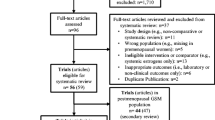Abstract
Introduction and hypothesis
Recurrent urinary tract infections (rUTIs) are commonly encountered in postmenopausal women. Optimal non-antimicrobial prophylaxis for rUTIs is an important health issue. The aim of this study was to evaluate the use of estrogen in the prevention of rUTIs versus placebo.
Methods
Eligible studies published up to December 2019 were retrieved through searches of MEDLINE, Embase, and Cochrane Central Register of Controlled Trials and Database of Systematic Reviews. We included randomized controlled trials of estrogen therapies versus placebo regarding the outcomes of preventing rUTIs. Changes in vaginal pH and estrogen-associated adverse events were also analyzed.
Results
Eight studies including 4702 patients (2367 who received estrogen and 2335 who received placebo) were identified. Five studies including 1936 patients evaluated the use of vaginal estrogen, which resulted in a significant reduction in rUTIs (relative risk, 0.42; 95% CI, 0.30–0.59). Three studies including 2766 patients evaluated the outcomes of oral estrogen in the prevention of UTIs and showed no significant difference in the number of rUTIs compared to treatment with placebo (relative risk, 1.11; 95% CI, 0.92–1.35). Two studies reviewed changes in vaginal pH and showed a lower pH (mean difference, −1.81; 95% CI, −3.10−−0.52) after vaginal estrogen therapy. Adverse events associated with vaginal estrogen were reported, including vaginal discomfort, irritation, burning, and itching. There was no significance increase in the vaginal estrogen group (relative risk, 3.06; 95% CI, 0.79–11.90).
Conclusions
Compared with placebo, vaginal estrogen treatment could reduce the number of rUTIs and lower the vaginal pH in postmenopausal women.







Similar content being viewed by others
Abbreviations
- UTI:
-
urinary tract infection
- rUTI:
-
recurrent UTI
References
Raz R, Colodner R, Rohana Y, et al. Effectiveness of estriol-containing vaginal pessaries and nitrofurantoin macrocrystal therapy in the prevention of recurrent urinary tract infection in postmenopausal women. Clin Infect Dis. 2003;36:1362–8.
Wawrysiuk S, Naber K, Rechberger T, Miotla P. Prevention and treatment of uncomplicated lower urinary tract infections in the era of increasing antimicrobial resistance-non-antibiotic approaches: a systemic review. Arch Gynecol Obstet. 2019;300:821–8.
Raz R, Stamm WE. A controlled trial of intravaginal estriol in postmenopausal women with recurrent urinary tract infections. N Engl J Med. 1993;329:753–7.
Eriksen B. A randomized, open, parallel-group study on the preventive effect of an estradiol-releasing vaginal ring (Estring) on recurrent urinary tract infections in postmenopausal women. Am J Obstet Gynecol. 1999;180:1072–9.
Ferrante KL, Wasenda EJ, Jung CE et al (2019) Vaginal estrogen for the prevention of recurrent urinary tract infection in postmenopausal women: a randomized clinical trial. Female Pelvic Med Reconstr Surg.
Cardozo L, Benness C, Abbott D. Low dose oestrogen prophylaxis for recurrent urinary tract infections in elderly women. Br J Obstet Gynaecol. 1998;105:403–7.
Perrotta C, Aznar M, Mejia R, Albert X, Ng CW. Oestrogens for preventing recurrent urinary tract infection in postmenopausal women. Cochrane Database Syst Rev. 2008;2:CD005131.
Higgins JP, Altman DG, Gotzsche PC, et al. The Cochrane Collaboration's tool for assessing risk of bias in randomised trials. Br Med J. 2011;343:d5928.
Guyatt G, Oxman AD, Akl EA, et al. GRADE guidelines: 1. Introduction-GRADE evidence profiles and summary of findings tables. J Clin Epidemiol. 2011;64:383–94.
Simunić V, Banović I, Ciglar S, et al. Local Estrogen treatment in patients with urogenital symptoms. Int J Gynaecol Obstet. 2003;82:187–97.
Dessole S, Rubattu G, Ambrosini G, et al. Efficacy of low-dose intravaginal estriol on urogenital aging in postmenopausal women. Menopause. 2004;11:49–56.
Brown JS, Vittinghoff E, Kanaya AM. Urinary tract infections in postmenopausal women: effect of hormone therapy and risk factors. Obstet Gynecol. 2001;98:1045–52.
Kirkengen AL, Andersen P, Gjersøe E, Johannessen GR, Johnsen N, Bodd E. Oestriol in the prophylactic treatment of recurrent urinary tract infections in postmenopausal women. Scand J Prim Health Care. 1992;10:139–42.
Lüthje P, Hirschberg AL, Brauner A. Estrogenic action on innate defense mechanisms in the urinary tract. Maturitas. 2014;77:32–6.
Meister MR, Wang C, Lowder JL, Mysorekar IU (2019) Vaginal estrogen therapy is associated with decreased inflammatory response in postmenopausal women with recurrent urinary tract infections. Female Pelvic Med Reconstr Surg.
Santen RJ, Mirkin S, Bernick B, Constantine GD. Systemic estradiol levels with low-dose vaginal estrogens. Menopause. 2019;27:361–70.
Simon JA, Maamari RV. Ultra-low-dose vaginal estrogen tablets for the treatment of postmenopausal vaginal atrophy. Climacteric. 2013;16:37–43.
Dudley R, Philip TH, Linda C. The effect of hormones on the lower urinary tract. Menopause Int. 2013;19:155–62.
Santen RJ. Vaginal administration of estradiol: effects of dose, preparation and timing on plasma estradiol levels. Climacteric. 2015;18:121–34.
Author information
Authors and Affiliations
Contributions
Ying-Yu Chen: Protocol/project development, Data Collection and management, Data Analysis, Manuscript writing.
TH Su: Protocol/project development, Data collection and management.
HH Lau: Protocol/project development, Manuscript writing and editing.
Corresponding author
Ethics declarations
Financial disclaimer/conflict of interest
None.
Additional information
Publisher’s note
Springer Nature remains neutral with regard to jurisdictional claims in published maps and institutional affiliations.
Rights and permissions
About this article
Cite this article
Chen, YY., Su, TH. & Lau, HH. Estrogen for the prevention of recurrent urinary tract infections in postmenopausal women: a meta-analysis of randomized controlled trials. Int Urogynecol J 32, 17–25 (2021). https://doi.org/10.1007/s00192-020-04397-z
Received:
Accepted:
Published:
Issue Date:
DOI: https://doi.org/10.1007/s00192-020-04397-z




